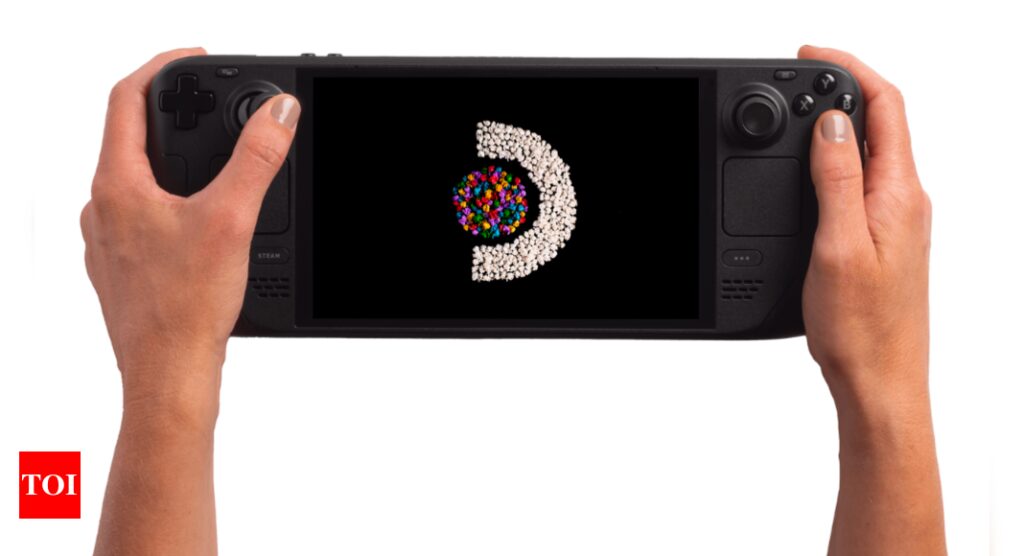[ad_1]
Valve has refreshed the Steam Deck with a new display and given it a new name, the Steam Deck OLED. As the name suggests, the Steam Deck no longer has an LCD screen; instead, it has an OLED, which supports HDR playback and can go as bright as up to 1,000 nits. Then, there is a bigger battery, faster Wi-Fi, and more to the new Steam Deck OLED.
Steam Deck OLED: Price and availability
The new OLED model comes in two storage options: 512GB for $549 and 1TB for $649.There is also a new carrying case for the 1TB model with a second smaller shell inside and a limited-edition transparent $679 model in the US and Canada. The OLED version of the Steam Deck goes on sale on November 16.
The 256GB LCD model is now available for $399/€419. The 64GB and 512GB LCD models are being phased out.
Steam Deck OLED: Features, specifications, and more
The new Steam Deck OLED has a bigger 7.4-inch custom RGB-stripe Samsung OLED, having a 1280×800 pixels resolution and a 90Hz refresh rate. For context, the older one has a 7-inch screen with a 60Hz of refresh rate. The OLED screen on the new model can display up to 110% of the DCI-P3 colour gamut, and has 1,000 nits of HDR peak brightness, up from 400 nits.
The battery capacity has been increased to 50 watt-hours from the previous 40Wh. The new model features an efficient die-shrink 6nm AMD “Sephiroth” APU, though the performance remains the same. The new model has the same NVMe M.2 2230 SSD storage modules but has a newer 6400MT/s memory and a larger heatsink and fan that is quieter but more effective. The speakers have also improved with better bass, higher fidelity haptics, and a redesigned trackpad for improved fidelity and edge detection.
Other upgrades include Wi-Fi 6E for faster downloads with new 6GHz connectivity, Bluetooth 5.3 with dedicated antenna, AptX HD and AptX Low Latency, wake via Bluetooth controller, and a longer 2.5m power cable. The charging rate is faster, with 20%–80% charge in as little as 45 minutes, and the battery life has been extended from two to eight hours to three to 12 hours.
There are also some design modifications, such as a multi-color indicator LED, Torx screws instead of Phillips, and machine screws on the rear cover with metal bosses for easier repair. The bumper switch is now on the joystick board for easier repair and improved bumper shock reliability, and fewer steps are required for ordinary repairs. Replacing the display no longer requires removing the back cover. It is also 30 grams lighter than the older one.
Steam Deck OLED: Price and availability
The new OLED model comes in two storage options: 512GB for $549 and 1TB for $649.There is also a new carrying case for the 1TB model with a second smaller shell inside and a limited-edition transparent $679 model in the US and Canada. The OLED version of the Steam Deck goes on sale on November 16.
The 256GB LCD model is now available for $399/€419. The 64GB and 512GB LCD models are being phased out.
Steam Deck OLED: Features, specifications, and more
The new Steam Deck OLED has a bigger 7.4-inch custom RGB-stripe Samsung OLED, having a 1280×800 pixels resolution and a 90Hz refresh rate. For context, the older one has a 7-inch screen with a 60Hz of refresh rate. The OLED screen on the new model can display up to 110% of the DCI-P3 colour gamut, and has 1,000 nits of HDR peak brightness, up from 400 nits.
The battery capacity has been increased to 50 watt-hours from the previous 40Wh. The new model features an efficient die-shrink 6nm AMD “Sephiroth” APU, though the performance remains the same. The new model has the same NVMe M.2 2230 SSD storage modules but has a newer 6400MT/s memory and a larger heatsink and fan that is quieter but more effective. The speakers have also improved with better bass, higher fidelity haptics, and a redesigned trackpad for improved fidelity and edge detection.
Other upgrades include Wi-Fi 6E for faster downloads with new 6GHz connectivity, Bluetooth 5.3 with dedicated antenna, AptX HD and AptX Low Latency, wake via Bluetooth controller, and a longer 2.5m power cable. The charging rate is faster, with 20%–80% charge in as little as 45 minutes, and the battery life has been extended from two to eight hours to three to 12 hours.
There are also some design modifications, such as a multi-color indicator LED, Torx screws instead of Phillips, and machine screws on the rear cover with metal bosses for easier repair. The bumper switch is now on the joystick board for easier repair and improved bumper shock reliability, and fewer steps are required for ordinary repairs. Replacing the display no longer requires removing the back cover. It is also 30 grams lighter than the older one.
[ad_2]
Source link











More Stories
Google Maps: Three privacy features coming to Google Maps on Android, iPhones
Most-Downloaded IPhone App: This Chinese app was the most-downloaded iPhone app in the US in 2023
Ukraine’s largest mobile operator goes offline for millions of users after cyber attack